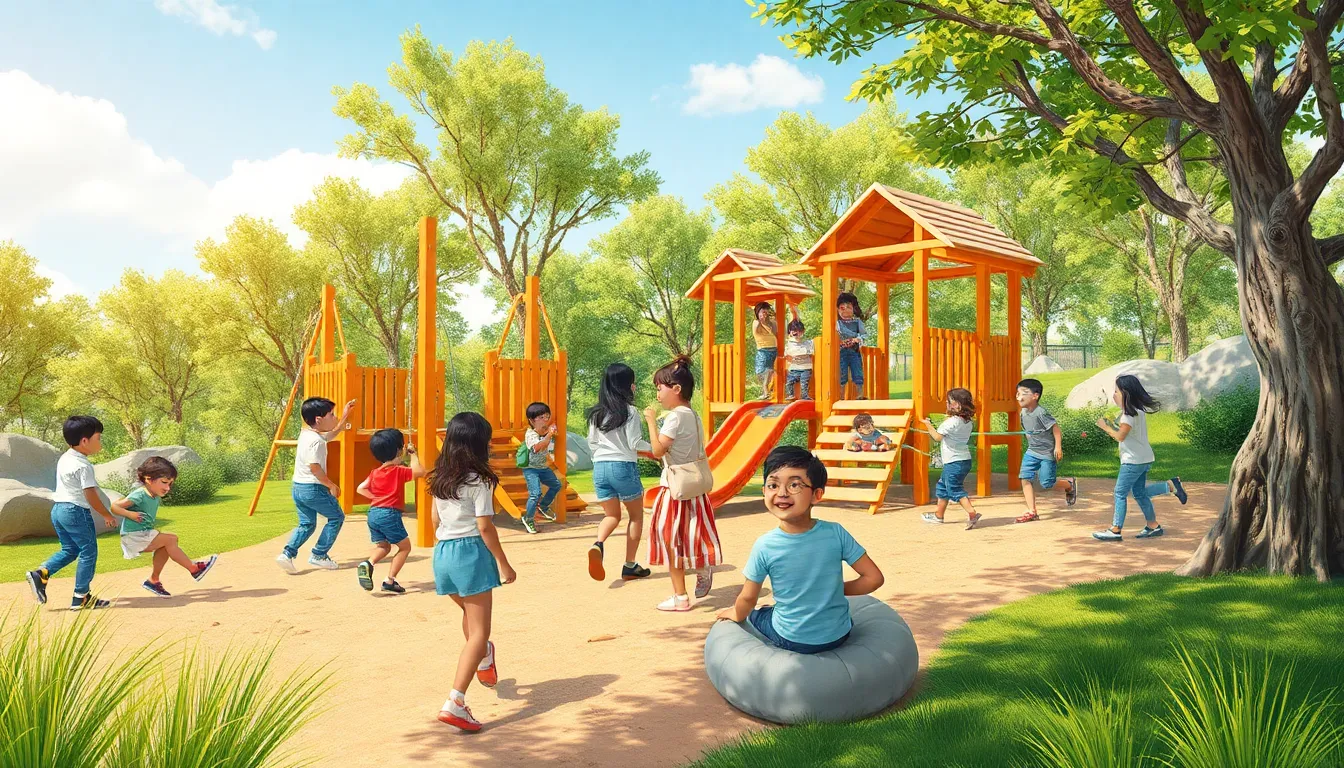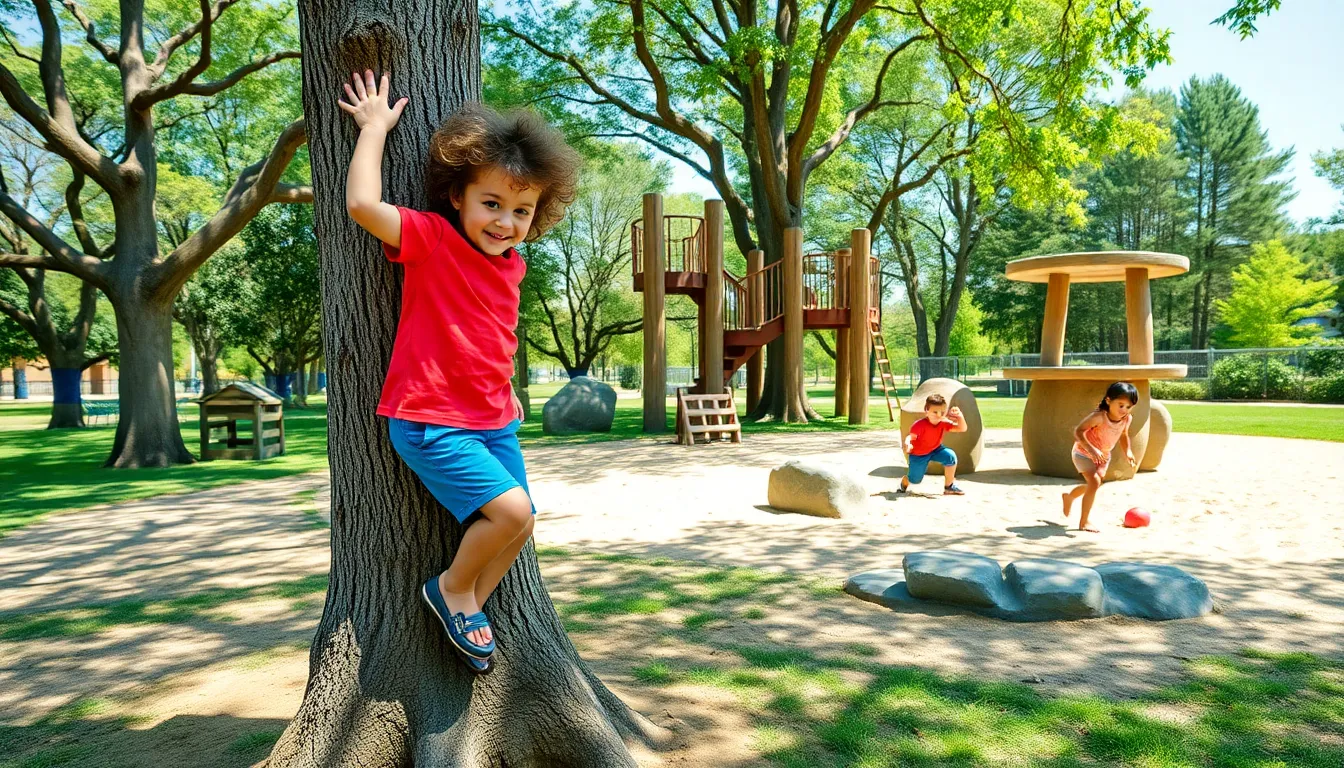Table of Contents
ToggleOutdoor play spaces are more than just swings and slides; they’re magical realms where imaginations run wild and friendships blossom. In early childhood, these vibrant environments serve as both playgrounds and classrooms, providing kids with opportunities to explore, learn, and grow. Who knew that climbing trees and digging in the dirt could be the building blocks of creativity and social skills?
Importance Of Outdoor Play Spaces In Early Childhood
Outdoor play spaces significantly impact young children’s development. They provide unique opportunities for physical, social, and cognitive growth in a natural environment.
Benefits For Physical Development
Playgrounds encourage active movement, helping children develop strength and coordination. Running and climbing enhance muscle development, improving overall health. Engaging in outdoor activities like jumping and balancing strengthens gross motor skills. Children also develop fine motor skills through activities like digging or manipulating small objects in sand. Moreover, exposure to the outdoors promotes physical health, reducing the risk of obesity. Early experiences in such environments lay the foundation for a lifelong appreciation of physical activity.
Benefits For Social Development
Interactions in outdoor play spaces foster essential social skills. Children learn cooperation through shared games, taking turns, and negotiating roles. Social engagement promotes empathy and conflict resolution abilities. They often form friendships as they explore and conquer challenges together. Outdoor settings allow diverse groups to interact, enhancing cultural awareness. Learning to work together helps develop communication skills vital for their future. Inclusive play encourages respect and acceptance of differences among peers.
Benefits For Cognitive Development
Outdoor play enhances cognitive development through exploration and discovery. Children solve problems by navigating different terrains and obstacles. They engage in imaginative play, stimulating creativity and critical thinking. Nature serves as a rich resource for learning opportunities, such as identifying plants or observing wildlife. Play spaces often incorporate educational elements, like sensory gardens, enhancing engagement. These experiences reinforce concepts such as counting, measuring, and understanding natural cycles. Ultimately, outdoor play spaces contribute significantly to comprehensive cognitive development.
Types Of Outdoor Play Spaces


Outdoor play spaces come in various forms, each contributing uniquely to children’s development. These spaces provide opportunities for exploration, physical activity, and social interaction.
Natural Playgrounds
Natural playgrounds incorporate elements like trees, rocks, and water. Trees provide climbing opportunities, while rocks can create balance challenges. These environments encourage imaginative play and connection to nature, enhancing sensory experiences. Unstructured spaces promote creativity as children invent games and narratives using natural elements.
Structured Play Areas
Structured play areas feature equipment specifically designed for active play. Swings, slides, and climbing frames support physical development by promoting strength and coordination. These areas often include safety surfaces, ensuring the child’s safety during playtime. Structured play encourages social interaction through cooperative games and activities, facilitating friendships and teamwork.
Flexible Play Environments
Flexible play environments adapt to a child’s needs and interests. These spaces may include open fields, sandboxes, or areas for group activities. Children can choose how to engage, fostering independent decision-making and creativity. Outdoor classrooms within these environments promote learning through hands-on experiences, blending education with play while allowing flexibility for various activities.
Designing Effective Outdoor Play Spaces
Designing outdoor play spaces requires thoughtful consideration of various factors that enhance children’s experiences. Attention to safety, nature, and accessibility fosters environments where children thrive.
Safety Considerations
Safety ranks paramount in outdoor play space design. Proper surfacing materials, like rubber or mulch, can significantly reduce injury risks. Equipment must comply with safety standards to safeguard children. Fencing around play areas prevents unsupervised exits, minimizing accidents. Regular maintenance checks ensure all structures remain safe and functional. Training staff on supervision techniques enhances incident prevention. Adequate shade protects children from sun exposure, promoting healthier play experiences.
Incorporating Nature
Integrating natural elements enriches outdoor play spaces. Trees, plants, and water features stimulate sensory exploration, sparking children’s interest in the environment. Natural landscapes inspire imaginative play and encourage interaction with nature. Elements like logs and boulders serve as climbing structures promoting physical activity. Wildlife observation opportunities cultivate curiosity and appreciation for biodiversity. Seasonal changes in nature provide diverse learning experiences year-round, supporting cognitive growth alongside physical activity.
Accessibility For All Children
Accessibility in play spaces ensures all children can enjoy outdoor activities. Designing universally accessible areas accommodates children with varying abilities. Providing adaptive equipment and inclusive pathways promotes participation for everyone. Clear signage aids navigation for children and caregivers alike. Incorporating sensory-rich zones serves children with sensory processing challenges. Flexibility in play environments allows children to engage at their comfort level, encouraging social interaction across diverse groups.
Encouraging Outdoor Play
Encouraging outdoor play involves engaging families, educators, and the community in creating enriching experiences for young children.
Strategies For Parents
Parents can prioritize outdoor play by scheduling regular outdoor activities. Planning weekend outings to parks or nature trails allows for exploration and adventure. Additionally, parents may set up playdates that encourage social skills through shared outdoor games. Creating a backyard play area with natural elements like sand or water fosters imaginative play. Involving children in choosing outdoor activities empowers them to express their interests and preferences.
Role Of Educators
Educators play a crucial role in facilitating outdoor play experiences. Incorporating outdoor time into daily schedules enhances children’s physical well-being and cognitive growth. Utilizing natural environments for lessons can make learning more engaging by directly connecting it to real-world experiences. Supporting teamwork through group activities in outdoor spaces helps children develop critical social skills. Observing children’s interactions provides valuable insights into their developmental progress.
Community Involvement
Community involvement strengthens outdoor play opportunities for children. Local governments can invest in diverse play spaces that cater to various interests and abilities. Organizing community events focused on outdoor activities promotes active participation and fosters friendships. Collaborating with schools to host play-based educational events bridges families and educators. Establishing community gardens invites children to learn about nature while nurturing teamwork and responsibility.










